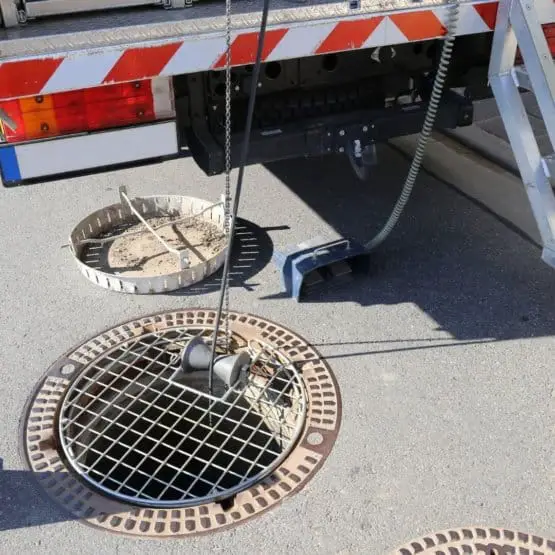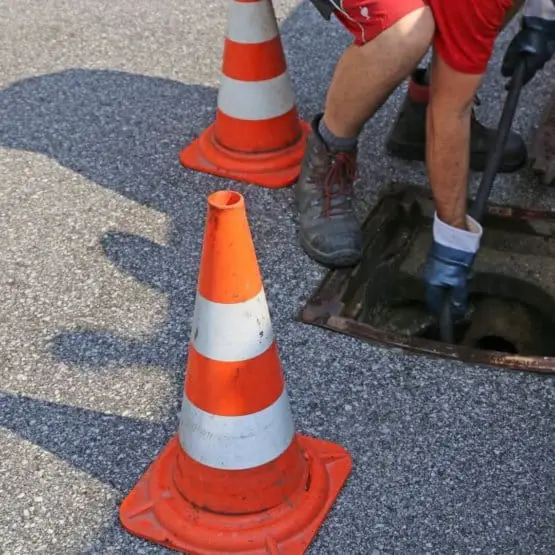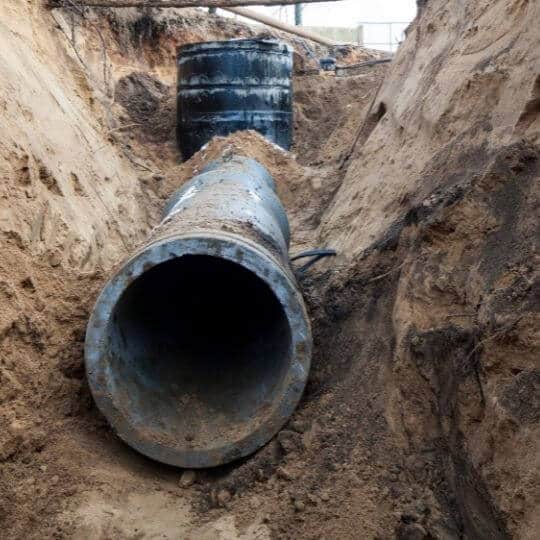What’s the right time to have your sewer line inspected? What will happen if you skip it? What to do when buying a home with sewer line issues? Find out here!
Even a minor sewer system issue can easily turn into a major one within a matter of hours if not treated properly. For instance, a damaged sewer system pipe can burst and cause raw sewage to pour out into your home, which causes further problems. The only right way to act in case of an emergency is to identify the cause of the problem as soon as possible by conducting a sewer line inspection.
Both cities and homes face sewer system problems, while city sewer inspections are in charge of solving them (although you can hire private companies as well but we will talk about that in a bit).
Sewer inspection company takes a closer look into the entire wastewater infrastructure typically by using camers or drones that provide visual data that helps with diagnosing and resolving the issue.
Today, we are going deep into the main signals and reasons why sewer inspection should be conducted, explaining in detail how sewer inspections work, what is the right way to act when buying or selling a house with sewer problems, and more related topics so let’s get started.
Why Conduct a Sewer Inspection?

If you are in doubt – should I get a sewer line inspection, here are a couple of reasons that clarify why having your sewer inspected is a must. First, you should do your best to avoid sudden emergencies by maintaining and inspecting your sewer system routinely, and, secondly, you should inspect the system whenever a problem, even if it looks like a minor one, occurs, to prevent major problems that come at major costs.
1) Regular Wastewater Infrastructure Maintenance Keeps You Away From Trouble
The best way to avoid potential wastewater infrastructure is to conduct sewer inspections proactively and regularly. A sewer system that has not been inspected in a year is more likely to be facing some issues compared to sewer lines that have been inspected within this time frame.
For this reason, cities around the world conduct regular cleanings and maintenance and sewer line inspections to keep sewer systems working properly. However, homeowners seem to be facing sewer system problems more often, possibly because they neglect the importance of having the system checked from time to time.
Some of the activities that should be taken in order to maintain your sewer line in good condition should include:
- Cleaning,
- Manhole inspection,
- Smoke testing,
- Root removal,
- CCTV inspection.
Here are just a few easy tips on how you can maintain your sewer system yourself at no cost:
- Do not flush anything besides toilet paper and human waste down the toilet. In this blog, we explained why you shouldn’t flush condoms and in this one why you shouldn’t flush tampons and feminine hygiene products in general.
- Use drain screens to prevent dental floss and hair clumps from entering your pipes.
- Keep cooking grease and food scraps out of your system. Instead of letting these down your sewer system, use a trash can to collect waste.
- We would recommend you to take care of your landscape – plants and trees, if it is possible, and if they are not already grown too large for you to handle them. Ideally, don’t plant shrubs and trees anywhere near the sewer line since roots can severely obstruct water and waste flow within the sewer line, which we will talk about more in the next paragraph.
Following this advice, you will be much less likely to be having any sewer line problems in the future, which will eliminate the chance of unpredicted investments.
2) Not Taking an Immediate Action Worsens the Problem
Strange, burbling sounds coming out of your toilet when you flush water as well as water that is getting stuck in the sink – these are some of the signs of a problem in your sewer system. If you can smell rotten eggs in your bathroom or kitchen, it is highly likely that sulfur is coming out of your clogged pipes.
If your sewer line has a poor layout, debris will be accumulated in the lower area, also known as the belly or sag, and will cause blockages that can, if not treated on time, result in an entire stoppage of the sewer system.
Tree roots growing and entering your sewer system bit by bit can obstruct the regular flow within the system as well, which requires immediate attention and action. We talked much about tree roots and related topics in other blogs such as what will bleach kill tree roots in a tree line, the best root killers for sewer lines, a homemade root killer for sewer lines as well as how much tree roots in sewer line cost to remove.
If sewer line pipes don’t line up properly or an environmental change changes the position of the pipes, the pipe sections will shift, which will result in an offset. A slight offset won’t obstruct a regular flow of waste, however, the nearer the offset to the bottom edge of the pipe, the more immediately you should have it fixed.
Oftentimes, degrease builds up in the sewer line, and waste and other materials traveling down the pipe just stick to it even more, causing a major clog. You can try to remove grease from the sewer line by using a high-pressure hose.
Pressurized water can wash away debris from the walls, although not necessarily. If you have waited for too long, maybe you will have no other choice but to call a plumber or a sewer line inspector.
If a large amount of sewage starts getting out and flooding your premises, you will know you are in trouble. Once this happens, you will have to call a professional that will have your sewer system inspected. However, they will have to drain the sewage first, since that is the only way of finding the root of a problem and fixing it.
In order to prevent situations like this and unnecessary costs, stick to the advice given in the previous paragraphs.
A Difference Between City and Home Sewer Inspection

A sewer inspection involves inspecting the sewer system conditions visually. However, when inspecting a home sewer system, a snake line, to which an inspection camera is attached, is used to reach critical areas and identify the issue within the pipe (collapsed lines, cracked pipes, tree roots, etc).
After the inspection, the snake line is taken out and camera footage is used to precisely locate and describe the problem.
A city sewer inspection is different since city pipes are much larger and inspectors can easily fit inside them. The inspectors use a flashlight in order to be able to see the issue with the naked eye and then fix it. However, thanks to the latest technologies, drones are being used to inspect pipes since these gadgets can capture high-quality videos no matter the condition within the pipe. [1]
Different Sewer Inspection Techniques
Four different sewer inspection techniques are listed below:
- Visual inspection,
- Lamping inspection,
- Camera inspection,
- CCTV inspection.
We already mentioned visual inspections when we talked about city inspectors that use flashlights and/or drones to determine the condition of wastewater structure.
A lamping inspection involves lowering a camera at the place where the manhole opening and the sewer line meet. This type of inspection provides low-quality visual data but still works with checking on low-priority pipes.
When doing a camera inspection, a camera is placed on a sled or raft, which is then inserted into the pipe to conduct an inspection.
CCTV stands for closed-circuit television and this type of inspection is conducted on pipes that have a narrow diameter – 4 to 48 inches max. CCTV inspection provides high-quality visual data since the camera is attached to a raft along with the lights while the raft moves in both vertical and horizontal directions, which provides full visibility of the pipe.
How Long Does a Sewer Inspection Take?
If the main sewer line is easy to access, a sewer inspection won’t take more than 30 minutes since the camera can travel through the system without difficulties. If accessing the main sewer line with a camera takes much longer, it is a clear sign of a clog within your sewer line.
How long does a sewer inspection take can also depend on the depth of your sewer lines. Typically, sewer lines are located at 4 to 8 feet in depth, depending on the climate where you live in. [2]
Selling a House With Sewer Problems

When people are looking to buy a new home, they focus on the interior mostly. However, in order to be able to move in right away, the home should be throughoutly inspected. Sewer lines should be on the list of the first things that should be examined before making a buying decision.
It doesn’t actually matter if you are buying or selling a vintage or modern home, this task is a must before listing your house for sale or signing a contract.
Selling a house with sewer problems, especially if you are well aware of the problem, is simply not fair since sewer repairs cost a lot and new owners wouldn’t be able to move in right away and enjoy their new living space.
Even if you think there are none sewer problems with your home, we still recommend hiring one of the best sewer inspection companies in your area. Here’s a list of reputable sewer line inspection companies in the USA:
- Elite Group,
- Vector Services,
- Underground Surveying,
- AmeriSpec.
Hiring one of these companies, or another company of your choice, will give you peace of mind when selling your house. Either there will be no problem at all so you can list it and sell it without deceiving anyone or you will fix the problem and list and sell the house only then.
Seller Won’t Fix Sewer Line
You want to buy a new house, yet, you also want to make sure there are no serious defects that can affect its structural integrity long-term. Thus, you make an offer, the seller accepts it, and a professional comes over to inspect the situation.
To make this clear, inspectors will always find certain defects and list them in a report. Water damage, mold, electrical hazards, and sewer line issues to name a few fall into the category of mandatory repairs.
If the seller won’t fix the sewer line despite the fact the report states there is a major issue, then you have three options – walking away, discussing having the problem fixed on your own while the seller would lower the initial price for the real estate they are trying to sell, or paying for the service 50/50.
Failed Sewer Inspection – What to Do Next?
Sometimes, sewer inspections fail. It could be that you didn’t have much luck with the company that you hired or that they faced an uncommon defect. There is one thing that can’t be detected even if you hire the best company in the town – a leak in your sewer line.
An inspection camera is not capable of locating a leak since it displays what is happening within and not outside the pipe. What can you do after a failed sewer inspection? You can either hire another sewer inspection company or talk to the one you have already hired and ask them to perform a leak isolation test.
Summary
Should I get a sewer line inspection? Sure thing! If you care about your home, sewer bils and your personal safety and finance, you should do regular sewer line inspections. If you are buying a new home, you should have the sewer line inspected as well. Either way, regular sewer line inspections will save you a lot of money and keep your home safe to live in.

Michael Davis is a heating & plumbing expert who currently works as independent contractor in SC. He also writes for Plumbertip.
For almost 10 years he worked on various plumbing tasks across South Carolina.



